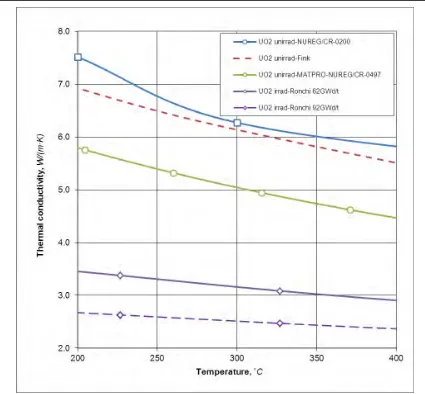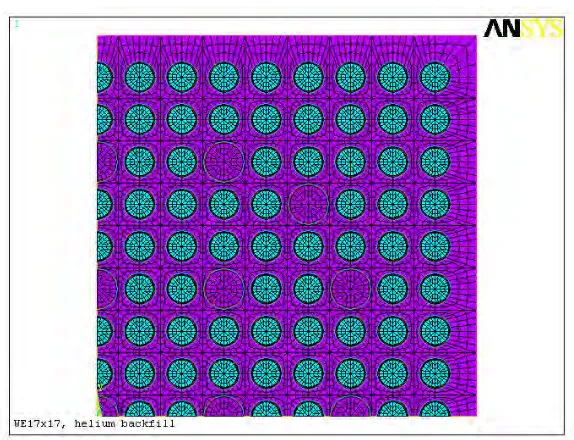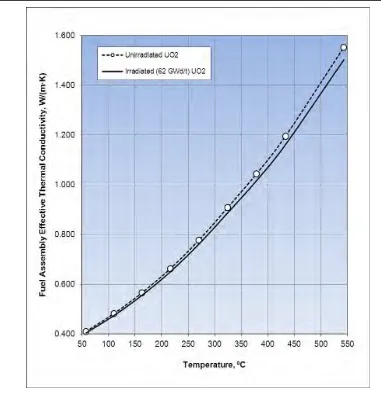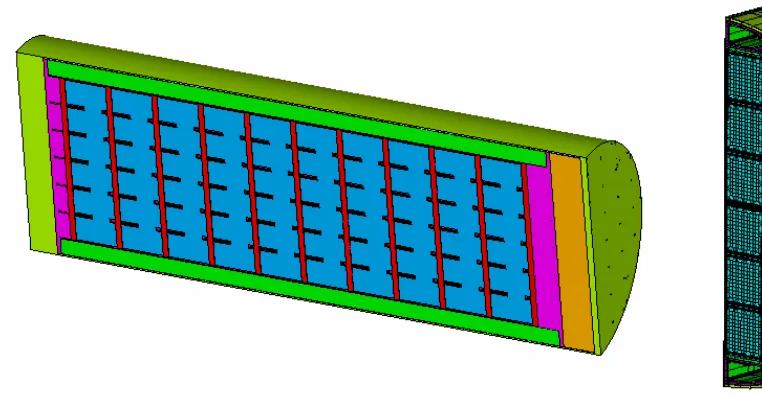EFFECT OF UO
2FUEL PELLET IRRADIATION ON FUEL CLADDING
TEMPERATURE IN DRY STORAGE SYSTEM FOR USED FUEL
ASSEMBLIES
Slava Guzeyev1, Jayant Bondre2, and Kamran Tavassoli3
1 Principal Engineer, Transnuclear Inc, Columbia, MD 2 Chief Operating Officer, Transnuclear Inc, Columbia, MD 3 Manager of Thermal Analysis, Transnuclear Inc, Columbia, MD
ABSTRACT
Irradiation of UO2 in fuel pellets reduces the thermal conductivity of irradiated used nuclear fuel.
The dry shielded canister (DSC) for storage and transportation of used nuclear fuel includes fuel compartments containing fuel assemblies (FAs). The transverse FA effective thermal conductivity for irradiated FA is lower than for unirradiated FA. The transverse FA effective thermal conductivity of irradiated FA is used for the DSC thermal analysis to evaluate effect on maximum fuel cladding temperature. The effect of UO2 irradiation on FA effective thermal properties and thermal analysis
results for a DSC are evaluated based on AREVA/Transnuclear DSC loaded with 32 pressurized water reactor (PWR) Westinghouse 17x17 FAs and fuel compartment dimension of 8.7x8.7 inches.
INTRODUCTION
Used nuclear fuel is stored in dry storage system inside a dry shielded canister (DSC). Fuel cladding and DSC component temperatures are calculated to demonstrate that they are below the limits to assure safe storage of used fuel assemblies. For the Transnuclear NUHOMS® System the methodology
used for calculation fuel cladding temperature is based on detailed finite element models and supported by test results.
This paper examines the effect of irradiated UO2 thermal conductivity on the temperature of fuel
assemblies that is stored in NUHOMS® storage system, which was analyzed before for unirradiated fuel
22nd Conference on Structural Mechanics in Reactor Technology
San Francisco, California, USA - August 18-23, 2013 Division IX The thermal analysis of a dry shielded canister (DSC) for used nuclear fuel is based on finite element model of DSC components and fuel assemblies (FAs) within fuel compartments. FAs are included in the DSC model as homogenized region. The FA effective thermal conductivity in transverse (radial) direction is calculated based on finite element FA model and uses thermal conductivity of UO2
fuel. The FA effective thermal conductivity in axial direction conservatively neglects thermal conductivity of fuel inside FA fuel rods.
The irradiated UO2 thermal conductivity is evaluated by Ronchi et al. (2004) for irradiation
temperatures from 680 to 1490 K and burnups from 34 to 94 GWd/t. A review of Ronchi et al. (2004) results shows that the thermal conductivity of irradiated UO2 drops significantly when burnups increase.
The unirradiated values are compared to interpolated irradiated UO2 values from Ronchi et al.
(2004) for 62 GWd/t FA average burnup. The comparison shown in Figure 1 indicates that the irradiated UO2 thermal conductivities are 50-60 percent less than unirradiated UO2 thermal conductivities for 62
GWd/t to 92 GWd/t FA average burnup. The Figure 1 includes unirradiated UO2 thermal conductivity
Figure 1. Unirratiated and Irradiated UO2 Thermal Conductivity
The results provided in Figure 1 show that the USNRC (1981) provide more conservative thermal conductivity for unirradiated UO2 fuel than USNRC (2000).
Effect of UO2 irradiation on transverse FA effective thermal conductivity is evaluated based on an
ANSYS® (2005) 2D finite element model for a Westinghouse 17x17 FA with helium backfill in compartment, using methodology described in Sanders et al. (1992).
For the comparison purpose, the effective thermal conductivity of Westinghouse 17x17 FA loaded in DSC is calculated using USNRC (1981) and Ronchi et al. (2004) UO2 thermal conductivity values. The
finite element FA model includes UO2 pellet, fuel rods, guide tubes, other assembly components, backfill
22nd Conference on Structural Mechanics in Reactor Technology
San Francisco, California, USA - August 18-23, 2013 Division IX
Figure 2. Typical Finite Element Model of Westinghouse 17x17 FA
Figure 3. Transverse FA Effective Thermal Conductivity
As shown in Figure 3, the transverse FA effective thermal conductivity for irradiated UO2 fuel is
decreased by ~3 percent compared to unirradiated fuel.
An increase of FA average burnup to 92 GWd/t decreases the UO2 fuel thermal conductivity by
additional 10 percent compared to 62 GWd/t FA average burnup and results in a negligible drop in FA effective thermal conductivity.
As a part of fuel assembly, UO2 fuel pellet property affects fuel cladding and DSC component
22nd Conference on Structural Mechanics in Reactor Technology
San Francisco, California, USA - August 18-23, 2013 Division IX Effect of UO2 fuel irradiation on thermal analysis of dry shielded canister (DSC) is evaluated using
an ANSYS 3D finite element model of DSC for transfer condition in a transfer cask with 46˚C ambient temperature. DSC model includes fuel assembly as homogenized regions within fuel compartment with FA effective thermal conductivity. See Figure 4 for finite element model of the DSC.
DSC model DSC slice cross-section
Figure 4. Finite Element Model of 32PTH DSC
The analysis results shows that maximum fuel cladding and fuel compartment temperatures considering irradiated UO2 fuel conductivity are 1˚F higher than values for unirradiated UO2 fuel, which
is negligible (0.16 percent). This result has negligible change with an increase of FA average burnup from 62 GWd/t to 92 GWd/t due to its negligible effect on FA effective conductivity.
Note that axial FA effective thermal conductivity is conservatively based on the fuel cladding material only and does not include the UO2 fuel pellet thermal conductivity. Therefore, the axial effective
conductivity is not impacted.
The effect of UO2 irradiation on FA effective thermal conductivity and DSC thermal results for
storage in a generic NUHOMS® DSC design with Westinghouse 17x17 FA is insignificant.
For engineering design of a storage/transportation system with 32 PWR FAs in DSC with a fuel compartment dimension of 8.7x8.7 inches, the UO2 fuel irradiation has negligible effect on the fuel
REFERENCES:
Ronchi, C., Sheindlin, M., Staicu, D., Kinoshita, M. (2004). “Effect of burn-up on the thermal
conductivity of uranium dioxide up to 100.000 MWdt,” Journal of Nuclear Materials 327
(2004) 58-76.
Popov, S. G., Ivanov, V. K., Carbajo, J. J., Yoder, G. L. (2000).“Thermophysical Properties of MOX
and UO2 Fuels Including the Effect of Irradiation,” ORNL/TM-2000/351.
Fink, J. K. (1999) “International Nuclear Safety Center Material Property Data Base,”
http://www.anl.insc.gov/matprop.
USNRC. (2000). “SCALE, A Modular Code System for Performing Standardized Computer Analysis
for Licensing Evaluation for Workstations and Personal Computers,” NUREG/CR-2000,
Rev. 6, ORNL/NUREG/CSD-2/V3/R6.
USNRC. (1981). “A Handbook of Materials Properties for Use in the Analysis of Light Water
Reactor Fuel Rod Behavior,” NUREG/CR-0497. MATPRO - Version 11 (Revision 2), EG&G
Idaho, Inc., TREE-1280.
ANSYS® Computer Code and On-Line User’s Manuals. (2005), Version 10.0, ANSYS, Inc.
Sanders, T. L., Seager, K. D., Rashid, Y. R., Barrett, P. R., Malinauskas, A. P., Einziger, R. E.,
Jordan, H., Duffey, T. A., Sutherland, S. H., Reardon, P. C. (1992). “A Method of
Determining the Spend Fuel Contribution to Transport Cask Containment Requirement,”



